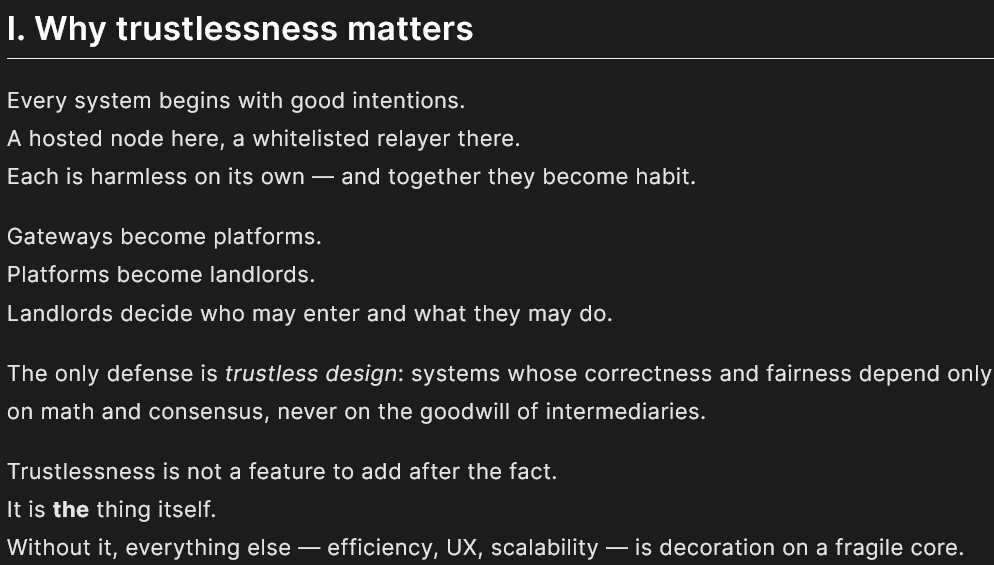The Ethereum Trustless Manifesto, authored by Vitalik Buterin and Ethereum Foundation researchers, urges developers to prioritize decentralization and avoid intermediaries that compromise trustlessness, ensuring the protocol remains censorship-resistant and permissionless from the start.
-
Trustlessness as core principle: Ethereum leaders emphasize that true decentralization cannot be retrofitted; it’s foundational to the network’s integrity.
-
Criticism of hosted nodes: Integrating centralized elements like hosted nodes or relayers erodes permissionlessness over time, even if initially convenient.
-
Real-world impact: During the recent Amazon Web Services outage, chains relying on single providers saw up to 25% throughput drops, highlighting resilience needs with data from Base, Arbitrum, and Optimism.
Ethereum Trustless Manifesto: Vitalik Buterin calls for unwavering decentralization in crypto building. Discover how this manifesto shapes Ethereum’s future and why trustlessness matters now. Read insights and key quotes today.
What is the Ethereum Trustless Manifesto?
Ethereum Trustless Manifesto is a declaration co-authored by Ethereum co-founder Vitalik Buterin and Ethereum Foundation researchers Yoav Weiss and Marissa Posner, published on Wednesday. It calls on blockchain developers to uphold trustlessness as the bedrock of decentralized systems, warning against the gradual introduction of centralized checkpoints that undermine permissionlessness. The manifesto stresses that without inherent trustlessness, enhancements like scalability and user experience are merely superficial additions to a vulnerable foundation.
Why Does the Ethereum Trustless Manifesto Emphasize Avoiding Intermediaries?
The Ethereum Trustless Manifesto highlights that platforms begin sacrificing trustlessness the moment they incorporate hosted nodes or centralized relayers, which may seem innocuous at first but foster dependency over time. According to the authors, each such addition acts as a potential choke point, reducing the network’s overall permissionlessness and making it susceptible to censorship. For instance, the document notes that success in Ethereum should be measured by “trust reduced per transaction” rather than raw transaction speeds, a metric that underscores the value of minimizing reliance on third parties. Expert analysis from Ethereum Foundation members, including quotes like “Trustlessness is not a feature to add after the fact. It is the thing itself,” reinforces this stance, drawing on historical precedents in blockchain development where early centralization led to governance issues. Supporting data from recent network events, such as the Amazon Web Services crash last month, illustrates the risks: Coinbase’s Base chain experienced approximately 25% throughput loss due to its AWS-hosted sequencer downtime, while Arbitrum and Optimism maintained full operations through diversified multi-cloud architectures. This comparison, derived from on-chain performance metrics, demonstrates how adherence to trustless principles enhances resilience. The manifesto, signed by additional contributors like Ethereum Foundation’s Tom Teman and researcher hitas.base.eth, serves as a reminder for builders to resist the temptation of convenience-driven centralization, ensuring Ethereum’s evolution aligns with its cypherpunk roots.
Ethereum co-founder Vitalik Buterin has taken a firm stand on preserving the network’s decentralized ethos through the newly released “Trustless Manifesto.” This document, co-signed by key figures in the Ethereum ecosystem, serves as a clarion call to developers: never compromise on trustlessness in the name of faster adoption or improved efficiency.
The manifesto articulates that trustlessness must be embedded from the outset, not tacked on later. “Without it, everything else—efficiency, UX, scalability—is decoration on a fragile core,” the authors assert. This perspective is particularly timely as Ethereum faces growing pressures from institutional adoption and scalability demands.

Extract from The Trustless Manifesto. Source: Trustlessness.eth
While the Ethereum Trustless Manifesto does not target specific entities, it implicitly critiques layer 2 solutions that prioritize speed over decentralization. Some Ethereum scaling networks have faced scrutiny for leaning on centralized components to accelerate user onboarding, potentially at the cost of the network’s core principles.
“We measure success not by transactions per second, but by trust reduced per transaction,” Buterin, Posner, and Weiss declare, shifting the focus from quantitative metrics to qualitative integrity.
The vulnerabilities of intermediary reliance were starkly exposed in the Amazon Web Services outage last month. Networks heavily dependent on single cloud providers suffered disruptions, with Base’s sequencer failure leading to significant slowdowns. In contrast, more decentralized setups like those in Arbitrum and Optimism proved robust, operating seamlessly across multiple providers. This event, analyzed through public blockchain explorers and infrastructure reports, validates the manifesto’s warnings about single points of failure.
Beyond the immediate signatories, the Ethereum Trustless Manifesto has garnered support from other ecosystem voices, including Tom Teman from the Ethereum Foundation and the pseudonymous researcher hitas.base.eth. Their endorsements lend further weight to the call for unwavering commitment to decentralization.
Frequently Asked Questions
What is the main goal of the Ethereum Trustless Manifesto?
The Ethereum Trustless Manifesto aims to remind developers that trustlessness is essential to blockchain’s value proposition. Authored by Vitalik Buterin and Ethereum Foundation experts, it argues against introducing centralized elements like hosted nodes, which erode permissionlessness and invite censorship risks, based on observed patterns in protocol evolution.
How does the Ethereum Trustless Manifesto relate to recent network outages?
The Ethereum Trustless Manifesto directly addresses vulnerabilities shown in events like the Amazon Web Services crash, where centralized dependencies caused up to 25% throughput drops in affected chains. It promotes multi-cloud strategies, as seen in resilient networks like Arbitrum, to maintain operations and embody true decentralization for everyday users.
This initiative builds on Buterin’s previous efforts to reinforce Ethereum’s foundational ideals. In December 2023, he published another piece advocating for a return to cypherpunk principles through advancements in zero-knowledge proofs, account abstraction, and privacy-enhancing technologies. These tools, he argued, are crucial for safeguarding user sovereignty amid increasing mainstream integration.
The timing of the Ethereum Trustless Manifesto coincides with heightened Wall Street interest in Ethereum. The launch of spot Ether exchange-traded funds in July 2023 marked a pivotal moment for institutional entry, followed by public companies adding ETH to their treasuries as a strategic asset. Despite this influx of capital and attention, the Ethereum Foundation and core developers remain steadfast in their technical priorities: advancing a roadmap that maximizes decentralization, self-sovereignty, and resistance to external controls.
Ethereum’s development community continues to iterate on protocol upgrades, such as those improving sharding and rollup integrations, all while keeping an eye on the trustless ethos. The manifesto’s release underscores a collective resolve to navigate adoption without diluting the network’s revolutionary potential. As Ethereum evolves, these principles will guide decisions, ensuring it remains a beacon for decentralized innovation.
Key Takeaways
- Trustlessness First: The Ethereum Trustless Manifesto positions trustlessness as the core of blockchain, not an optional enhancement, warning that early centralization compromises long-term integrity.
- Resilience Through Diversity: Real-world incidents like the AWS outage highlight how multi-provider setups, as in Arbitrum and Optimism, outperform single-point reliant systems, reducing downtime risks.
- Measure by Trust Reduction: Developers should prioritize minimizing trust per transaction over speed metrics, fostering a more permissionless ecosystem for sustainable growth.
Conclusion
The Ethereum Trustless Manifesto, led by Vitalik Buterin and supported by Ethereum Foundation experts, reaffirms the imperative of decentralization in blockchain development, cautioning against intermediaries that threaten censorship resistance. As institutional adoption accelerates with ETH ETFs and corporate treasury allocations, this document ensures Ethereum’s path forward honors its trustless foundations. Builders and users alike should heed its message, prioritizing permissionless innovation to secure the network’s future resilience and sovereignty.
